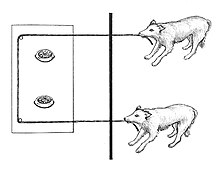
The cooperative pulling paradigm is an experimental design in which two or more animals pull rewards toward themselves via an apparatus that they cannot successfully operate alone. Researchers (ethologists, comparative psychologists, and evolutionary psychologists) use cooperative pulling experiments to try to understand how cooperation works and how and when it may have evolved.
The type of apparatus used in cooperative pulling experiments can vary. Researcher Meredith Crawford, who invented the experimental paradigm in 1937, used a mechanism consisting of two ropes attached to a rolling platform that was too heavy to be pulled by a single chimpanzee. The standard apparatus is one in which a single string or rope is threaded through loops on a movable platform. If only one participant pulls the string, it comes loose and the platform can no longer be retrieved. Only by pulling together in coordination can the participants be successful; success by chance is highly unlikely. Some researchers have designed apparatus that involve handles instead of ropes.
Although many animals retrieve rewards in their cooperative pulling tasks, the conclusions regarding cooperation are mixed and complex. Chimpanzees, bonobos, orangutans, capuchins, tamarins, wolves, elephants, ravens, and kea appear to understand the requirements of the task. For example, in a delay condition, the first animal has access to the apparatus before the other. If the animal waits for its partner before pulling, this suggests an understanding of cooperation. Chimpanzees, elephants, wolves, dogs, ravens, and kea wait; grey parrots, rooks, and otters fail to wait. Chimpanzees actively solicit help when needed. They appear to recall previous outcomes to recruit the most effective partner. In a group setting, chimpanzees punish initial competitive behavior (taking food without pulling, displacing animals) such that eventually successful cooperation becomes the norm.
As for the evolution of cooperation, evidence from cooperative pulling experiments provides support for the theory that cooperation evolved multiple times independently. The fact that basic characteristics of cooperation are present in some mammals and some birds points to a case of convergent evolution. Within social animals, cooperation is suspected to be a cognitive adaptation.